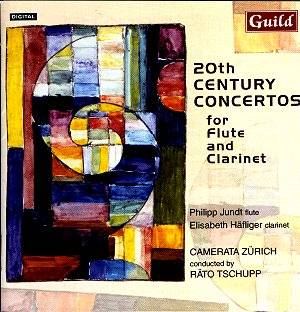Here are four rare Swiss concertos for wind instruments.
They will provide provocative and sometimes testing listening for anyone
who is already won over by the Nielsen wind concertos and wants to know
where to go next. The Schaeuble and the Haller are the most approachable.
The Vogel and the Blum embrace various brands of dissonance though not
the wilder extremities explored by the likes of 1970s vintage Thea Musgrave,
Alexander Goehr and Maxwell Davies. There is no Malcolm Arnold counterpart
in this group. All the concertos/concertinos are with string orchestra.
Haller was born in Burgdorf
and studied with Volkmar Andreae and Czesław Marek as well as attending
Paul Hindemith's lectures at Zürich University. High office in the Swiss
musical establishment came his way and he might well be viewed
as a career counterpart to William Schuman in the USA. He spent some
time in Paris with Nadia Boulanger and French charm does, I think,
show through in this double concerto. The outer movements after a quiet
introduction in the case of the first tend towards vortices of capricious
energetic activity. The wilder moments seems to suggest a gale-buffeted
tree in full leaf. The flute and clarinet often shadow each other's
material. Think in terms of late Nielsen and Lennox Berkeley - lyrical
with the lightest libation of vinegar. The liner-notes speak of twelve-note
rows but the technique is by no means belligerently present.
Vogel was born in Moscow (where he was influenced by
Scriabin - not apparent in this concertino), moved to Berlin after the
Great War and was then swept to Switzerland by the Nazi rise to power.
His music is more 'advanced' and fragmented than Haller's work but preserves
a slightly acidic Bergian immediacy. The style sometimes recalls 1960s
Penderecki and at others the Schoenbergian writing of Humphrey Searle.
However Blum's Clarinet Concerto is a much more lyrical work than my
first listening suggested.
Schaeuble's warm and lambent Concertino is an elysian
work in an idiom that might be compared with Fauré with Bergian
edginess. It is in five movements played without break.
The sound throughout is very agreeable. The performers
are responsive and they are well advocated by Guild's sound engineers.
How pleasing to see the name of Räto Tschupp as
conductor. Sad however to discover that he died on 12 February 2002.
He was founder and director of Camerata Zürich. His name may ring
a bell with you. Thirty years ago he was the conductor of a Beethoven
piano concerto cycle with the pianist Hanae Nakajima and (I think) the
Hamburg Philharmonic. The first LP to appear included The Emperor.
It made a major splash at the time coming out of total obscurity and
without the benefit of any form of media marketing. The LPs, in pretty
rudimentary packaging, were sold through Woolworths in the UK and at
something like 87p stocks of each shifted like hot cakes. They were
praised to the skies in some quarters. Yet Nakajima disappeared from
view (unless you know better) and similarly Herr Tschupp. As it turns
out he became a hardworking figure in Switzerland's musical life being
a particular champion for 20th century music and the dedicatee of many
new works. He premiered more than one hundred such works during his
career.
The notes are lucid and detailed as one would expect
from Chris Walton.
Rob Barnett


